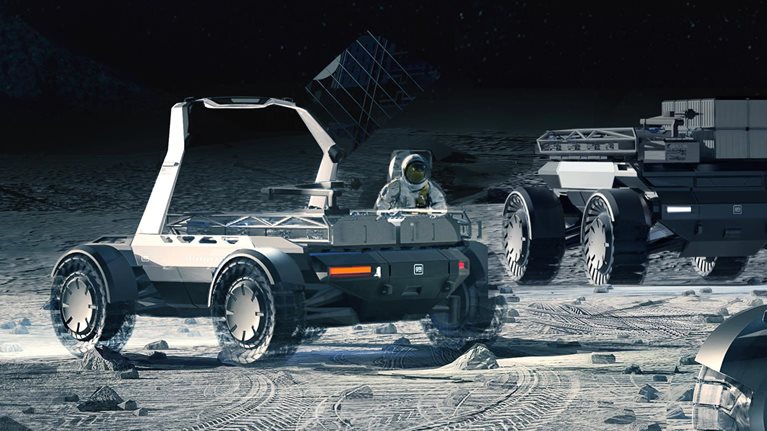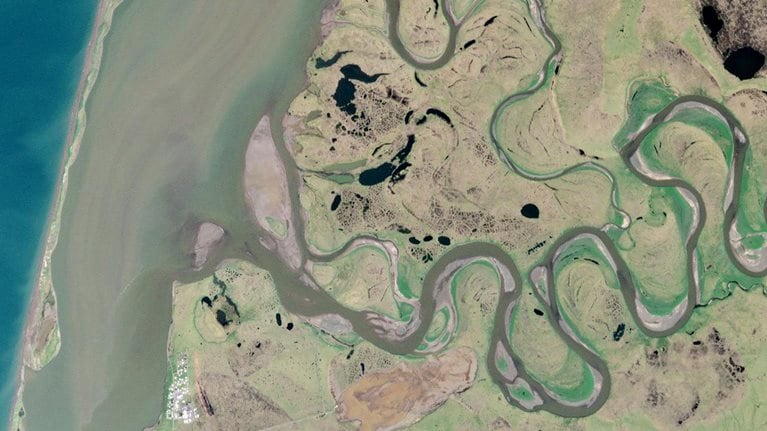GPS. Weather reports. Lightning-fast communication. Over the past two decades or so, these kinds of unprecedented innovations are commonplace to millions of humans—and all of them are bolstered by space technology. In this episode of the At the Edge podcast, Lisa Callahan, vice president and general manager of commercial civil space at Lockheed Martin, joins senior partner Lareina Yee in conversation about the new kinds of space technology that could impact the future of business and government on earth and in outer space and the value that could be created.
An edited transcript of the discussion follows. For more conversations on cutting-edge technology, follow the series on your preferred podcast platform.
Podcast transcript
Mina Alaghband: Experts say the space market could exceed $1 trillion dollars by 2030. What’s it mean to have an infrastructure and an economy in space?
If people are going to be able to live and work in space and create money in space, you need infrastructure. And a lot of that infrastructure isn’t that different from what we have here on Earth.
Mina Alaghband: That’s Lockheed Martin’s Lisa Callahan. She’s the vice president and general manager of commercial civil space. She joins senior partner Lareina Yee in conversation about the future of an economy in space. Welcome to At the Edge, a production of the McKinsey Technology Council.
Lareina Yee: Lisa, thank you for joining us today. Analysts suggest the space market could exceed $1 trillion by 2030. Can you tell us a little bit about the scientific and technological advances we’re seeing, specifically for the space-to-earth economy?
Lisa Callahan: This is an exciting time for space. There are more new entrants joining this community, and more international space stations than ever before. When I think about the technological advances and how space is driving earth’s economy, two areas really come to mind.
One is GPS, since we build the GPS satellites for the Space Force. The other is weather, because we build the geostationary operational environmental satellite (GOES-R) series of spacecraft for the National Oceanic and Atmospheric Administration (NOAA) and NASA.
GPS is about a $300 billion per year business here on Earth, and since its inception it’s estimated to have generated $1.4 trillion in the US alone. Just look at the rideshare industry, which is a $60 billion business annually, and all thanks to space assets providing those GPS signals. Weather is very similar, with the US weather satellite market worth $162 billion a year, with space assets totaling about 77 percent of that. So space is really playing a huge role in the economy here on Earth.
The other thing I would highlight is the fact that our weather assets are protecting our economy. One of the objectives of the GOES weather satellite series is to improve forecasting for severe weather events like lightning, hurricanes, and tornadic activity. And the interesting thing from the perspective of protecting our economy is that for every mile of coastline we evacuate, it costs us tens of billions of dollars in economic impact.
So if we can improve the accuracy of our predictions to pinpoint coastal areas where a hurricane will actually hit and reduce the number of evacuations, we’re saving billions of dollars in economic impact from just one storm. The more we use our space assets to increase our accuracy in predicting these storms, the better off we’ll be in terms of saving lives and protecting our economy as well.
Lareina Yee: Is this something people are just waking up to? Or did something change in the technology? Or are these long-standing trends we’re just starting to catalyze?
Lisa Callahan: I would say the public may not yet fully understand how dependent they are on space. So I love to use these examples to help them understand why investment in space has a massive multiplier effect in terms of the return on that investment on our economy.
Subscribe to the At the Edge podcast
Lareina Yee: Can you tell us a little bit about how advances in technology are also going to change some of the use cases going forward?
Lisa Callahan: Let’s consider how we can leverage innovations happening here on Earth to benefit us in space—for example, space exploration and taking humans farther into the frontier than we’ve ever been before. In order to enable a kind of space economy—and by that I mean actually creating revenue in space as opposed to creating revenue on Earth for space—you need an infrastructure in space.
Because if people are going to be able to live and work in space and create money in space, you need infrastructure. And a lot of that infrastructure isn’t that different from what we have here on Earth. So non-aerospace industries are going to become space companies, whether they know it or not.
For example, we’re partnering with General Motors to build a lunar rover, leveraging their expertise in autonomous vehicles and their battery technology as they electrify their fleet. And taking those innovations here on Earth and bringing them into the space market is something that really gives me a lot of energy and excitement. GM is not a space company, but they are going to participate in the space economy.
Another really great example is the Orion spacecraft we’re getting ready to launch for NASA’s Artemis 1 test flight around the moon. We have a partnership with Amazon and their Alexa product, as well as Cisco and their Webex products. There’s no crew on Artemis 1, but we’re going to launch a test payload to certify it for future crewed flights, and VIPs at mission control in Houston will be able to talk to Orion, follow her progress, and receive data from the spacecraft.
And the fun thing is we’re using technologies people already have in their homes, like Alexa or Webex, and people at home will be able to ask their Alexa what’s happening on Orion. They can simply say, “Alexa, fly me to space,” and get information about the Artemis mission.
Lareina Yee: It’s hard to believe that that’s possible. With so many use cases, which ones are you most excited about? If you could invest an extra venture-capital billion dollars, where would you put it?
Lisa Callahan: I think autonomy’s going to be a big thing. We’ve been exploring Mars since the ’70s with robotic vehicles, and we’ve covered only a fraction of the surface. But if we could use the autonomous technology found in self-driving cars here on Earth and install it in our rovers—something we’re trying to do with GM—we could cover more of that surface and learn more about the resources on other planets.
Because, in the end, to build that infrastructure, we’re going to depend on the resources on those planets to further our space exploration, rather than bringing all those resources with us from Earth. I’m talking about things like using robots to crack the ice on the lunar surface to create drinking water or crack the hydrogen and oxygen into fuel to enable us to launch rockets from the surface of the moon to go even deeper into space. And that’s going to take autonomy and robotics.
Another area we’re looking at is additive manufacturing and 3-D printing. Logistically, we can’t take everything we need with us, so we’re going to have to create some of that in space as well. And being able to create what you need, such as spare parts, is another pretty exciting area that could really help us along the way.
Lareina Yee: Let’s fast-forward to 2080. Give us a preview. What does a space economy look like?
Lisa Callahan: First off, there’s a space economy. In other words, we are making money in space. At that point, I think people are working and living on the moon and living on Mars as well, because we’re building up that infrastructure.
We’re using those heavenly bodies to take humans even farther into deep space. Maybe we’ve got folks on their way to Jupiter or some other celestial body that would help us to understand and discover some of the secrets of the universe. But I think by the ’80s, we definitely have people on the moon. And we have humans on Mars exploring and going from there.
Lareina Yee: With that exciting future, tell us about some of the uncertainties. What keeps you up at night as you think about that trajectory?
Lisa Callahan: One of the biggest challenges, and I think about it from a people perspective, is the sheer distance and time involved. We’ve been living at the International Space Station for more than two decades now. But it’s easy to phone home and ask for help. We’re only hours away from Earth if there’s a problem. The moon is a little farther away, but still only days away if you need to get back.
When we’re talking about going to Mars or other planets in our solar system, we’re talking about a multiyear journey. For instance, it’s nine months to get to Mars from Earth, and then you must wait another three months for the planets to align again before beginning the return trip.
So when we start sending humans farther into our solar system, it’s going to require them to be more self-sufficient for us to give them the things they need to solve problems on their own. That’s where things we’re doing with digital assistants on Orion will be really helpful, so they can query what’s happening on their spacecraft. They could also have digital tools that allow them to view a digital twin of the spacecraft they’re on so that they can debug problems on their own.
A lot of exciting things may be happening on the medical front, too. These astronauts are really going to be in the wilderness, if you will, and need ways to treat each other if someone gets hurt or ill. So maybe we could use 3-D printing to manufacture medical devices.

McKinsey Technology Trends Outlook 2022
Lareina Yee: That list covers so many different sectors, technologies, and parts of the ecosystem. How does the collaboration work? I’m sure it’s global and multi-sectored. Give us a sense of how that works today.
Lisa Callahan: The International Space Station is a great example, where we have dozens of countries supporting and contributing to that effort. Artemis and the work we’re doing with NASA to return humans to the moon is very similar and involves a multinational government agreement known as the Artemis Accords.
It’s a very collaborative environment, because in space, there are no borders. For example, one of the things we need to think about is lunar architecture, since once we start building bases on the moon, we need standards for buildings and interfaces. That way any nation or space agency with an innovative idea or product can contribute in a sort of plug-and-play way.
Lareina Yee: For people who may not be immersed in this sector, can you tell us about the James Webb Space Telescope and the promise it holds for our understanding of the universe?
Lisa Callahan: The James Webb Space Telescope is the next great observatory helping us to look beyond our solar system and into different galaxies. It can literally take us back in time billions of years to understand the formation of Earth and the galaxies.
And Lockheed Martin is excited to have been a part of that effort by building the NIRCam instrument, a near-infrared (NIR) imager and sensor that keeps the 18 mirrors of the James Webb Space Telescope perfectly aligned. The pictures it’s beaming back are just incredible, thanks to the advances in technology and imaging. The Hubble Space Telescope was state of the art for its time, but a side-by-side comparison with images from James Webb reveals far higher fidelity than anything we saw with Hubble.
The thing I still struggle to wrap my head around is that we’re looking backwards in time. All of this helps us to understand what’s happened to planets in our solar system and what might be happening here on Earth. Giving us those insights can really help us protect our planet and understand the secrets of the universe, especially the question a lot of people ask, which is, are we alone? Are there other species out there?
Lareina Yee: Can we expect that you’ll be on one of these space missions soon?
Lisa Callahan: I’m not sure I would qualify as a NASA astronaut. But maybe someday we’ll get to the point where space is accessible and affordable for everyone. And if that’s the case, you can count on me to be there.
Lareina Yee: What advice do you have for women and girls who aspire to be pioneers like you?
Lisa Callahan: Help each other out. There are a lot of women who helped me move and advance throughout my career. But a lot of men helped me as well and have been my sponsor and my advocate. Building those networks and having those advocates have been helpful to me.
Also, when we look for jobs, if there are ten qualifications and we don’t meet them all, we’re conditioned to say, “Well, I don’t have all ten of those, so I’m not qualified for the job.” But that’s not true. Because if you have all ten, that job is beneath you. You’re not going to be challenged by it. So helping and encouraging each other is really important. And don’t do it alone. Reach out and get help.
Lareina Yee: Lisa, final question: What is your favorite space technology?
Lisa Callahan: I think my favorite space technology is around power. Without power, we can’t really do anything, on Earth or in space, and the more of it, the better. So from a technology perspective, nuclear and solar power are the two big areas that can really help us in space.
Lareina Yee: Thank you so much, Lisa, for joining us.
Lisa Callahan: Thank you, too. I appreciate it.
At the Edge is a production of the McKinsey Technology Council. Contact us at McKinsey_Technology_Council@mckinsey.com.


